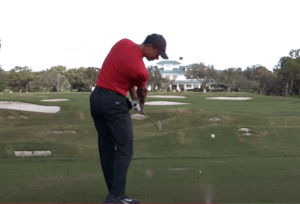Introduction
Are you looking to take your golf game to the next level? One crucial factor that can greatly impact your performance is the compression of the golf ball. Understanding how to properly compress the ball can lead to longer drives, improved accuracy, and ultimately, lower scores. In this introductory article, we will delve into the art of compressing the golf ball, exploring various techniques and strategies that can help you unlock your true potential on the course.
As you embark on this journey to enhance your golfing skills, it is essential to comprehend the concept of compression. When a golf ball is compressed correctly, it undergoes a transformation that optimizes its energy transfer upon impact with the clubface. This results in increased distance and control, allowing you to achieve greater consistency in your shots.
Throughout this article, we will explore the factors that contribute to effective ball compression. From swing speed and club selection to ball construction and compression ratings, we will delve into the intricacies of each element and their impact on the compression process. By understanding these variables, you will be able to make informed decisions that align with your unique playing style and goals.
Furthermore, we will discuss various techniques and drills that can help you improve your ability to compress the golf ball. From developing a proper swing path to maximizing your body rotation, we will provide practical tips and insights that can be applied to your training regimen. Whether you are a beginner seeking to establish a solid foundation or an experienced golfer aiming to refine your skills, this article will serve as a valuable resource for honing your ball compression technique.
In the following sections, we will delve deeper into each aspect of compressing the golf ball, providing comprehensive guidance and expert advice. So, if you’re ready to unlock the secrets to longer, more accurate shots, join us as we embark on this journey to master the art of compressing the golf ball. Let’s tee off on the path to success!
How to Compress the Golf Ball
Compressing the golf ball is a technique that can greatly improve your game. By understanding how to compress the ball properly, you can achieve greater distance and accuracy in your shots. In this article, we will explore various tips and techniques to help you compress the golf ball effectively.
One of the key factors in compressing the golf ball is having the correct impact position. The ball should be struck with a slightly descending blow, allowing for maximum compression. To achieve this, it is important to have a forward shaft lean at impact. This can be achieved by ensuring your hands are ahead of the ball at impact.
Another important aspect of compressing the golf ball is generating clubhead speed. The faster the clubhead speed, the more compression you can achieve. To increase clubhead speed, focus on a smooth and controlled swing, utilizing your body’s rotation and proper weight transfer.
Additionally, the type of golf ball you use can also affect compression. High-compression balls are designed to be compressed more easily, resulting in greater distance. Experiment with different types of golf balls to find one that suits your swing and helps you achieve the desired compression.
Furthermore, it is crucial to have a consistent and solid strike on the golf ball. This can be achieved by practicing your swing and maintaining good balance throughout. A solid strike will ensure optimal compression and maximize the distance and accuracy of your shots.
In conclusion, compressing the golf ball is a skill that can greatly enhance your game. By focusing on impact position, clubhead speed, ball selection, and a solid strike, you can achieve the desired compression and improve your overall performance on the course. Keep practicing and refining these techniques to take your golf game to the next level.
Factors Affecting Compression
Compression is a crucial aspect of golf ball performance, as it directly impacts distance, control, and feel. Understanding the factors that affect compression can help golfers choose the right ball for their game and optimize their performance on the course.
One of the primary factors influencing compression is the construction of the golf ball. Golf balls are typically made with a core, mantle layer, and cover. The materials used and their thickness determine the compression level. Balls with a softer core and thinner cover tend to have lower compression, while those with a harder core and thicker cover have higher compression. Golfers with slower swing speeds may benefit from low compression balls, as they compress more easily, resulting in increased distance.
Another factor to consider is swing speed. Faster swing speeds generate more force upon impact, leading to higher compression. Golfers with faster swings may prefer high compression balls, as they provide better control and feel. Conversely, slower swing speeds may struggle to compress high compression balls, resulting in reduced distance and feel.
Temperature also plays a role in compression. Warmer temperatures cause the air inside the ball to expand, resulting in lower compression. In contrast, colder temperatures cause the air to contract, leading to higher compression. Golfers should consider the weather conditions when selecting a ball, as it can affect its performance.
Lastly, the type of golf ball dimples can impact compression. Different dimple patterns can alter the way a ball interacts with the air, affecting compression. Golfers should experiment with different dimple designs to find one that suits their swing and playing conditions.
In conclusion, several factors influence the compression of a golf ball. Construction, swing speed, temperature, and dimple design all play a role in determining the compression level. By understanding these factors, golfers can make informed decisions about the type of ball that will best suit their game and optimize their performance on the course.
Choosing the Right Golf Ball Impact Angle
When it comes to compressing the golf ball, selecting the right impact angle is crucial. By understanding how the angle of impact affects the compression, you can maximize your distance and accuracy on the golf course.
One important factor to consider is the loft of your club. Different clubs have different lofts, and each requires a specific impact angle to achieve optimal compression. For example, a driver typically has a lower loft, so a shallower impact angle is needed to compress the ball effectively. On the other hand, a wedge with a higher loft requires a steeper impact angle.
Another aspect to consider is your swing speed. A higher swing speed generally requires a shallower impact angle to avoid excessive backspin and maintain control. Conversely, a slower swing speed may benefit from a steeper impact angle to generate more spin and lift.
The type of golf ball you choose also plays a role in determining the ideal impact angle. Different balls have varying compression rates, and finding the right match for your swing is essential. A softer ball will compress more easily, requiring a shallower impact angle, while a harder ball will require a steeper angle for optimal compression.
To determine the ideal impact angle for your swing, experimentation is key. Take note of the ball flight and distance achieved with different angles of impact. Adjust your setup and swing accordingly until you find the sweet spot that maximizes compression and performance.
In conclusion, choosing the right golf ball impact angle is essential for compressing the ball effectively. Consider factors such as club loft, swing speed, and ball type to find the optimal angle that suits your game. By mastering this aspect of your swing, you can achieve greater distance and accuracy on the golf course.
Swing Speed
Swing speed is a crucial factor when it comes to compressing the golf ball and achieving maximum distance. It refers to the speed at which the golfer swings the clubhead through the impact zone. A higher swing speed can result in greater compression of the ball, leading to increased ball speed and longer shots.
To increase your swing speed, it is important to focus on various aspects of your swing technique. One key factor is the sequencing of your body movements. Proper sequencing allows for a more efficient transfer of energy from the ground up, resulting in increased clubhead speed. Start by initiating the downswing with your lower body, followed by the rotation of your torso and finally the release of the clubhead.
Another aspect to consider is the position of your hands and wrists during the swing. Maintaining a firm grip and a flat left wrist (for right-handed golfers) at impact can help maximize the compression of the ball. This allows for a more solid strike and optimal transfer of energy.
Additionally, it is essential to have a well-fitted golf club. The shaft flex and weight should be suited to your swing speed and tempo. A club that is too stiff or too light can negatively affect your ability to compress the ball effectively. Consult with a professional club fitter to ensure that your equipment is optimized for your swing.
Lastly, regular exercise and flexibility training can contribute to increased swing speed. Strengthening your core muscles and improving your flexibility can enhance your ability to generate power and speed in your swing.
In conclusion, swing speed plays a vital role in compressing the golf ball. By focusing on proper sequencing, hand position, club fitting, and physical conditioning, you can improve your swing speed and achieve greater compression, resulting in longer and more powerful shots.
Golf Ball Construction
When it comes to compressing a golf ball, understanding its construction is essential. Golf balls are carefully designed to maximize distance and control, and their construction plays a crucial role in achieving these goals.
Modern golf balls are typically made up of several layers, each serving a specific purpose. The outermost layer, known as the cover, is responsible for providing durability and control. It is usually made of materials like urethane or Surlyn, which offer a good balance between softness and durability.
Beneath the cover lies the mantle layer, which helps control the ball’s spin and trajectory. The mantle is made of a high-energy polymer that enhances the ball’s overall performance. This layer is crucial in determining how the ball will respond to different swing speeds and shots.
The core is the innermost layer of the golf ball and is responsible for generating maximum distance. Cores are typically made of a high-energy rubber compound or a combination of rubber and other materials. The compression of the core plays a significant role in how the ball feels and performs.
To compress a golf ball effectively, it is important to understand the relationship between swing speed and compression. Golfers with slower swing speeds should opt for lower compression balls, as they compress more easily and provide better distance. On the other hand, golfers with faster swing speeds should choose higher compression balls for better control and accuracy.
In conclusion, understanding the construction of a golf ball is crucial when it comes to compressing it effectively. The cover, mantle, and core all play a significant role in determining the ball’s performance. By choosing the right compression based on your swing speed, you can optimize your distance and control on the golf course.
Temperature EffectsCompression vs. Distance
When it comes to compressing a golf ball, one factor that often gets overlooked is temperature. The temperature of the ball can have a significant impact on its compression and ultimately, the distance it travels. Understanding this relationship is crucial for golfers looking to optimize their performance on the course.
As temperatures rise, golf balls tend to become softer. This increased softness allows for greater compression upon impact with the clubface. When a ball is compressed, it stores energy, which is then released upon contact, propelling the ball forward. So, in warmer weather, golfers can expect their shots to travel further due to the increased compression.
Conversely, in colder temperatures, golf balls become harder and less compressible. This means that the energy transfer upon impact is not as efficient, resulting in shorter shots. It’s important for golfers to take this into account when playing in colder conditions, as they may need to adjust their club selection or swing to compensate for the reduced compression.
To illustrate the impact of temperature on compression and distance, let’s consider an example. Imagine a golfer hitting a drive on a hot summer day. The warm temperature causes the ball to compress more upon impact, resulting in a powerful shot that travels a significant distance. Now, picture the same golfer hitting a drive on a chilly winter morning. The cold temperature makes the ball less compressible, leading to a weaker shot that falls short of the desired distance.
In conclusion, temperature plays a crucial role in the compression of a golf ball and ultimately, the distance it travels. Golfers must be aware of this relationship to optimize their performance on the course. So, the next time you’re out playing golf, take a moment to consider the temperature and how it may affect your shots.
Compression vs. Control
When it comes to golf, two key factors that players often consider are compression and control. These elements play a crucial role in determining the distance and accuracy of your shots. Understanding the relationship between compression and control can help you improve your game and achieve better results on the course.
Compression refers to the amount of force applied to the golf ball at impact. A higher compression ball requires more force to compress, resulting in increased distance. On the other hand, a lower compression ball requires less force, providing better control and feel. It’s important to find the right balance between compression and control to optimize your performance.
One way to compress the golf ball is by using proper swing mechanics. Generating more clubhead speed and transferring that energy efficiently to the ball can increase compression. This can be achieved through a smooth and powerful swing, utilizing the correct body rotation and weight transfer.
Another factor that affects compression is the type of golf ball you choose. Different golf balls have varying compression ratings, ranging from low to high. Players with slower swing speeds may benefit from using a lower compression ball, as it allows for better compression and control. Conversely, players with faster swing speeds may prefer a higher compression ball to maximize distance.
Additionally, the impact angle can also influence compression. Striking the ball with a downward angle of attack can increase compression, while a shallower angle can decrease it. Experimenting with different impact angles during practice can help you find the optimal compression for your swing.
In conclusion, finding the right balance between compression and control is essential for golfers looking to improve their game. By understanding the relationship between these two factors and implementing proper swing mechanics, choosing the right golf ball, and adjusting impact angles, you can achieve optimal compression and control, resulting in more accurate and powerful shots on the course.
In conclusion, understanding how to compress the golf ball is crucial for any golfer looking to improve their game. Throughout this post, we have explored various factors that affect compression, as well as the importance of choosing the right golf ball.
One of the key points covered was the impact angle. By striking the ball with a descending blow, you can increase compression and achieve greater distance. Additionally, swing speed plays a significant role in compression. The faster the swing, the more compression you can achieve.
We also discussed the importance of golf ball construction. Different materials and designs can impact compression and result in varying levels of distance and control. It is essential to choose a golf ball that aligns with your swing characteristics and playing style.
Temperature effects on compression were another crucial topic covered. Understanding how temperature can impact the compression of the golf ball allows you to make adjustments accordingly and optimize your performance on the course.
Furthermore, we compared compression to distance and control. While high compression may provide greater distance, it can compromise control. Finding the right balance is key to achieving optimal performance.
Looking ahead, advancements in golf ball technology may continue to impact compression. Manufacturers are consistently developing new materials and designs to enhance performance. Keeping up with these developments can give you an edge on the course.
Thank you for taking the time to read this post. We hope you found the information helpful and insightful. We encourage you to leave any comments or feedback you may have. Remember, mastering the art of compressing the golf ball can significantly improve your game. So, keep practicing and applying the tips discussed in this post. Good luck on your golfing journey!









